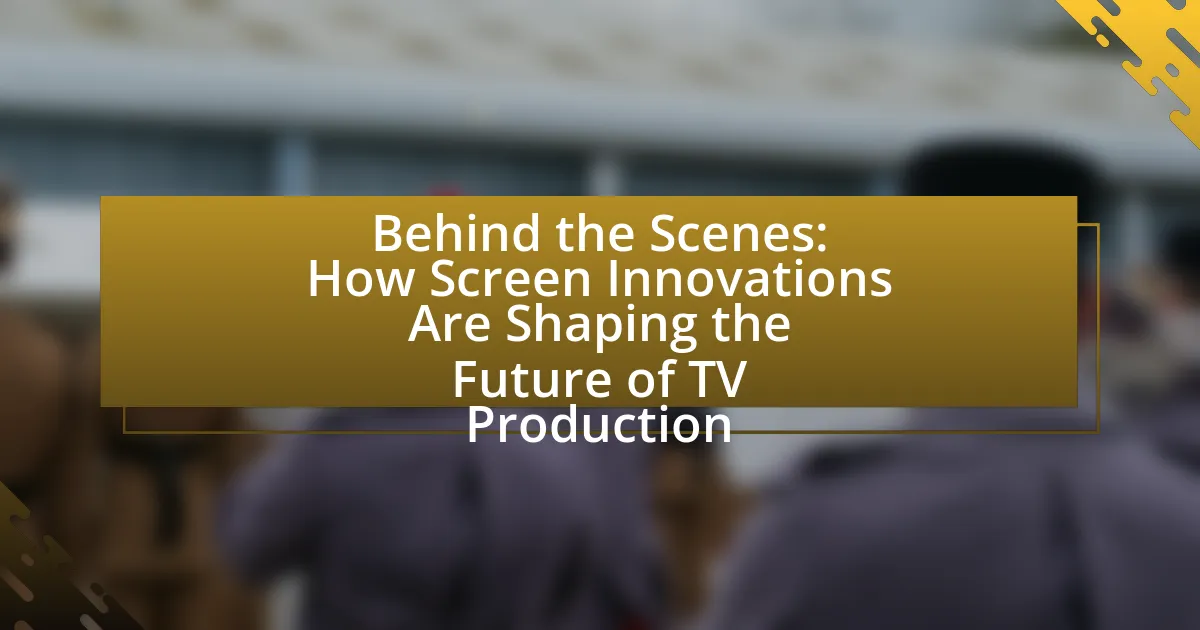Screen innovations in TV production encompass advancements in display technology that enhance visual storytelling and production efficiency. Key technologies include LED screens for virtual sets, OLED, MicroLED, and augmented reality, which allow for real-time background changes and immersive environments, significantly reducing the need for physical sets and location shoots. These innovations streamline production processes, improve visual quality, and enable new storytelling techniques, ultimately transforming traditional methods and addressing challenges such as high costs and inefficiency. The article explores the impact of these technologies on production workflows, viewer engagement, and future trends, highlighting the importance of adopting best practices for successful implementation in the evolving landscape of television production.

What are Screen Innovations in TV Production?
Screen innovations in TV production refer to advancements in display technology and techniques that enhance visual storytelling and production efficiency. These innovations include the use of LED screens for virtual sets, which allow for real-time background changes and immersive environments, significantly reducing the need for physical sets and location shoots. For example, the use of large-scale LED walls, as seen in productions like “The Mandalorian,” enables filmmakers to create dynamic backgrounds that respond to camera movements, enhancing realism and reducing post-production time. Such technologies are transforming traditional production methods, making them more flexible and cost-effective.
How do screen innovations impact the production process?
Screen innovations significantly enhance the production process by improving efficiency, reducing costs, and enabling creative possibilities. For instance, advancements in LED screen technology allow for real-time background changes, which minimizes the need for extensive location shoots and reduces logistical challenges. A study by the American Society of Cinematographers highlights that using virtual production techniques, such as those seen in “The Mandalorian,” can cut down on production time by up to 50% while providing filmmakers with greater flexibility in visual storytelling. These innovations streamline workflows, allowing for faster turnaround times and more dynamic content creation.
What technologies are considered screen innovations?
Screen innovations include technologies such as OLED (Organic Light Emitting Diode), MicroLED, MiniLED, and Quantum Dot displays. OLED technology offers superior contrast and color accuracy by allowing individual pixels to emit light, while MicroLED and MiniLED enhance brightness and energy efficiency. Quantum Dot displays improve color reproduction through nanometer-sized semiconductor particles. These advancements are reshaping the visual experience in TV production, enabling higher resolutions and more immersive viewing experiences.
How do these technologies enhance visual storytelling?
Technologies such as augmented reality (AR), virtual reality (VR), and advanced CGI enhance visual storytelling by creating immersive experiences that engage audiences on a deeper emotional level. These technologies allow creators to visualize complex narratives and environments, making stories more relatable and impactful. For instance, AR can overlay digital elements onto the real world, providing context and depth to scenes, while VR can transport viewers into entirely new worlds, allowing them to experience the story from unique perspectives. Studies have shown that immersive storytelling can increase viewer retention and emotional connection, as evidenced by a 2020 report from the Interactive Advertising Bureau, which found that 70% of participants felt more engaged with content that utilized AR or VR elements.
Why are screen innovations crucial for modern TV production?
Screen innovations are crucial for modern TV production because they enhance visual quality, streamline production processes, and enable new storytelling techniques. High-definition displays, OLED technology, and advancements in LED screens allow for richer colors and sharper images, significantly improving viewer engagement. Additionally, innovations like virtual production techniques, exemplified by the use of LED walls in shows such as “The Mandalorian,” reduce the need for extensive location shoots and allow for real-time background changes, thereby increasing efficiency and creativity in production. These advancements not only elevate the aesthetic appeal of television content but also transform the logistical aspects of how shows are made, making them essential in the competitive landscape of modern media.
What challenges do traditional methods face?
Traditional methods in TV production face challenges such as inefficiency, high costs, and limited flexibility. These methods often rely on extensive physical sets and locations, which can lead to increased production time and expenses. For instance, a study by the Producers Guild of America found that traditional filming can incur costs upwards of $500,000 per episode due to location scouting and set construction. Additionally, traditional methods struggle to adapt quickly to changing viewer preferences and technological advancements, making it difficult to incorporate innovative techniques like virtual production or real-time rendering. This lack of adaptability can hinder a production’s ability to remain competitive in a rapidly evolving industry.
How do screen innovations address these challenges?
Screen innovations address challenges in TV production by enhancing visual quality, improving efficiency, and enabling creative flexibility. For instance, advancements such as LED volume technology allow filmmakers to create immersive environments that reduce the need for extensive location shoots, thereby saving time and costs. Additionally, high dynamic range (HDR) and 4K resolution technologies provide superior image clarity and color accuracy, which enhances the viewer’s experience. These innovations also facilitate real-time visual effects integration, allowing for immediate feedback during production, which streamlines the workflow and reduces post-production time.

What are the Key Types of Screen Innovations?
Key types of screen innovations include OLED (Organic Light Emitting Diode), MicroLED, and Mini-LED technologies. OLED screens provide superior contrast and color accuracy due to their ability to emit light individually from each pixel, which enhances the viewing experience significantly. MicroLED technology offers similar benefits but utilizes microscopic LEDs to create images, resulting in higher brightness and energy efficiency. Mini-LED, on the other hand, improves traditional LCD screens by using smaller LEDs for backlighting, allowing for better local dimming and improved picture quality. These innovations are transforming TV production by enabling more dynamic visuals and enhancing storytelling capabilities.
What role does virtual production play in TV production?
Virtual production plays a crucial role in TV production by integrating real-time technology and digital environments to enhance storytelling and streamline production processes. This innovative approach allows filmmakers to create immersive settings using LED screens and game engine technology, significantly reducing the need for physical sets and location shoots. For instance, shows like “The Mandalorian” have utilized virtual production techniques to create expansive worlds, demonstrating how this method can save time and costs while providing creative flexibility. The use of virtual production has been shown to improve collaboration among departments, as visual effects can be integrated during filming rather than in post-production, leading to a more efficient workflow.
How does virtual production change the filming environment?
Virtual production transforms the filming environment by integrating real-time digital technology with traditional filmmaking techniques. This approach allows filmmakers to create immersive backgrounds and environments using LED screens and game engine technology, significantly reducing the need for physical sets and location shoots. For instance, productions like “The Mandalorian” have utilized virtual production to achieve complex visual effects on set, enabling immediate adjustments and enhancing creative flexibility. This method not only streamlines the production process but also minimizes logistical challenges associated with location shooting, such as travel and weather-related delays.
What are the benefits of using virtual sets?
The benefits of using virtual sets include enhanced flexibility, cost efficiency, and improved visual quality. Virtual sets allow for dynamic backgrounds and environments that can be easily modified or changed without the need for physical construction, thus saving time and resources. Additionally, they enable seamless integration of live-action footage with computer-generated imagery, resulting in higher production values. According to a study by the University of Southern California, productions utilizing virtual sets can reduce set construction costs by up to 30% while increasing creative possibilities, demonstrating their significant advantages in modern TV production.
How is augmented reality utilized in TV shows?
Augmented reality (AR) is utilized in TV shows to enhance storytelling and viewer engagement by integrating digital elements into live-action scenes. For example, AR allows for the addition of virtual graphics, animations, and information overlays that interact with the physical environment, creating immersive experiences. A notable instance is the use of AR in sports broadcasts, where real-time statistics and graphics are displayed on the field, providing viewers with enhanced context and information. This application of AR not only captivates audiences but also transforms traditional viewing experiences into interactive ones, as seen in shows like “The Weather Channel,” which uses AR to visualize weather patterns and forecasts in a more engaging manner.
What are the applications of augmented reality in storytelling?
Augmented reality (AR) enhances storytelling by creating immersive experiences that engage audiences in interactive narratives. AR applications in storytelling include interactive books, where readers can visualize characters and settings through their devices, and location-based experiences, such as AR-enhanced tours that provide contextual information about historical sites or fictional narratives tied to real-world locations. Additionally, AR is utilized in film and television production to visualize scenes during pre-production, allowing creators to experiment with visual effects and set designs in real-time. This technology has been effectively employed in projects like “The Walking Dead: Our World,” which integrates AR gameplay with the show’s narrative, demonstrating its potential to deepen audience engagement and expand storytelling possibilities.
How does augmented reality enhance viewer engagement?
Augmented reality enhances viewer engagement by creating immersive experiences that allow audiences to interact with content in real-time. This technology overlays digital information onto the physical world, making the viewing experience more dynamic and participatory. For instance, studies have shown that AR can increase viewer retention rates by up to 70%, as it encourages active participation rather than passive consumption. By integrating interactive elements, such as 3D models or live data, augmented reality captivates viewers’ attention and fosters a deeper emotional connection to the content.

What Future Trends Can We Expect in Screen Innovations?
Future trends in screen innovations include the rise of MicroLED technology, flexible displays, and advancements in augmented reality (AR) and virtual reality (VR) integration. MicroLED technology offers superior brightness and energy efficiency compared to traditional OLED screens, making it a preferred choice for high-end displays. Flexible displays enable new form factors, allowing screens to be curved or rolled, enhancing user experience and design versatility. Additionally, the integration of AR and VR into screen technology is expected to revolutionize content consumption, providing immersive experiences that blend digital and physical environments. These trends are supported by ongoing research and development in display technologies, indicating a significant shift in how screens will be utilized in various applications, particularly in TV production.
How will AI influence screen innovations in TV production?
AI will significantly influence screen innovations in TV production by enhancing content creation, streamlining workflows, and personalizing viewer experiences. For instance, AI algorithms can analyze vast amounts of data to predict audience preferences, enabling producers to tailor content more effectively. Additionally, AI-driven tools like automated editing software and virtual production environments, such as those used in “The Mandalorian,” allow for more efficient and creative filming processes. These innovations not only reduce production costs but also improve the quality of visual effects and storytelling, as evidenced by the increasing use of AI in generating realistic CGI and optimizing post-production tasks.
What are the potential applications of AI in scriptwriting and editing?
AI can significantly enhance scriptwriting and editing by automating content generation, improving dialogue quality, and providing real-time feedback. For instance, AI algorithms can analyze existing scripts to suggest plot developments or character arcs, thereby streamlining the creative process. Additionally, tools like Grammarly and ProWritingAid utilize AI to refine language, ensuring clarity and coherence in dialogue. Research from the University of Southern California highlights that AI can predict audience reactions based on script elements, allowing writers to tailor their narratives for better engagement. These applications demonstrate AI’s potential to revolutionize the scriptwriting and editing landscape in TV production.
How can AI improve production efficiency?
AI can improve production efficiency by automating repetitive tasks and optimizing workflows. For instance, AI algorithms can analyze production schedules and resource allocation, leading to better time management and reduced costs. A study by McKinsey & Company found that AI can increase productivity in manufacturing by up to 20%, demonstrating its potential to streamline operations. Additionally, AI-driven analytics can provide real-time insights, allowing teams to make informed decisions quickly, further enhancing efficiency in production environments.
What emerging technologies should we watch for?
Emerging technologies to watch for in TV production include virtual production, artificial intelligence, and augmented reality. Virtual production, exemplified by the use of LED walls and real-time rendering, allows filmmakers to create immersive environments that enhance storytelling while reducing location costs. Artificial intelligence is transforming post-production processes, enabling faster editing and content personalization through machine learning algorithms. Augmented reality is being integrated into live broadcasts, providing viewers with interactive experiences that blend digital elements with real-world footage. These technologies are reshaping the landscape of TV production, driving innovation and efficiency in content creation.
How might 5G technology transform live broadcasting?
5G technology will transform live broadcasting by enabling ultra-low latency, high-definition video streaming, and enhanced connectivity for multiple devices. This advancement allows broadcasters to transmit high-quality content in real-time, significantly improving viewer experiences. For instance, 5G networks can support data rates exceeding 10 Gbps, which facilitates seamless streaming of 4K and 8K video without buffering. Additionally, the increased bandwidth allows for more cameras and drones to be connected simultaneously, providing diverse angles and perspectives during live events. This capability is crucial for sports and entertainment industries, where real-time engagement and high-quality visuals are essential for audience retention and satisfaction.
What advancements in display technology are on the horizon?
Advancements in display technology on the horizon include MicroLED, OLED evolution, and enhanced resolution displays. MicroLED technology offers superior brightness and energy efficiency, with companies like Samsung leading the development, showcasing prototypes that promise better color accuracy and longevity compared to traditional LED displays. OLED technology is evolving with improvements in lifespan and manufacturing processes, as seen in LG’s advancements that aim to reduce burn-in issues while enhancing color performance. Additionally, 8K resolution displays are becoming more prevalent, with manufacturers like Sony and Samsung investing in content creation and upscaling technologies to support this higher resolution, thereby enhancing viewer experience in TV production.
What are Best Practices for Implementing Screen Innovations?
Best practices for implementing screen innovations include thorough research and development, collaboration among stakeholders, and iterative testing. Research and development ensure that the technology aligns with production needs and audience expectations, while collaboration fosters creativity and problem-solving among directors, producers, and technical teams. Iterative testing allows for adjustments based on real-world feedback, enhancing the final product’s quality. For instance, the integration of LED screens in film production has been validated by projects like “The Mandalorian,” where the use of virtual production techniques significantly improved visual fidelity and reduced location costs.
How can production teams effectively integrate new technologies?
Production teams can effectively integrate new technologies by adopting a structured approach that includes training, collaboration, and iterative testing. Training ensures that team members are proficient in using new tools, which enhances productivity and reduces errors. Collaboration among departments fosters a shared understanding of technology’s role in production, leading to more innovative applications. Iterative testing allows teams to evaluate the effectiveness of new technologies in real-time, making adjustments as necessary to optimize workflows. For instance, a study by the International Journal of Production Research highlights that organizations that implement continuous training and collaborative practices see a 30% increase in technology adoption success rates.
What common pitfalls should be avoided when adopting screen innovations?
Common pitfalls to avoid when adopting screen innovations include inadequate training for staff, failure to assess compatibility with existing systems, and neglecting to consider the long-term costs associated with maintenance and upgrades. Inadequate training can lead to underutilization of new technologies, as employees may not fully understand how to leverage the innovations effectively. Compatibility issues can result in operational disruptions, as new screens may not integrate seamlessly with current production workflows. Additionally, overlooking long-term costs can strain budgets, as ongoing expenses for support and updates can accumulate significantly over time. These pitfalls can hinder the successful implementation of screen innovations in TV production.

Leave a Reply